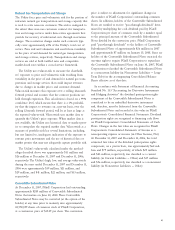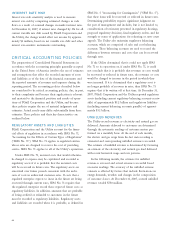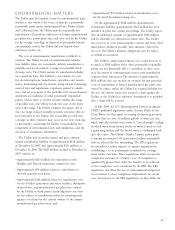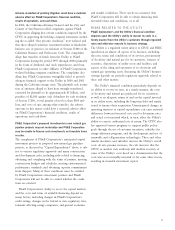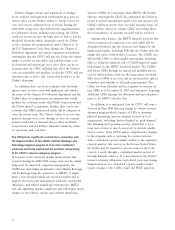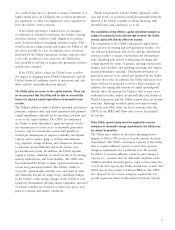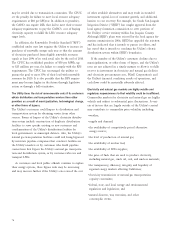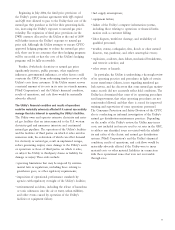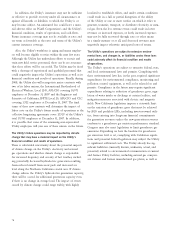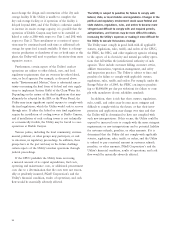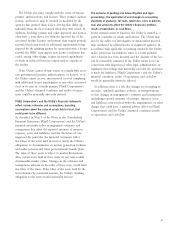PG&E 2007 Annual Report Download - page 75
Download and view the complete annual report
Please find page 75 of the 2007 PG&E annual report below. You can navigate through the pages in the report by either clicking on the pages listed below, or by using the keyword search tool below to find specific information within the annual report.73
If the Utility incurs signifi cant costs to implement
MRTU, including the costs associated with CRRs, that are
not timely recovered from customers; if the new market
mechanisms created by MRTU result in any price/market
fl aws that are not promptly and effectively corrected by
the market mechanisms, the CAISO, or the FERC; if the
Utility’s CRRs are not suffi cient to hedge the fi nancial risk
associated with its CAISO-imposed congestion costs under
MRTU; if either the CAISO’s or the Utility’s MRTU-related
systems and software do not perform as intended or if
the CPUC adopts comprehensive changes to its resource
adequacy program that materially affect the Utility’s
obligations under that program, the current cost of capacity,
or the means by which the Utility procures that capacity,
PG&E Corporation’s and the Utility’s fi nancial condition,
results of operations, and cash fl ows could be materially
adversely affected.
The Utility may be unable to identify and implement new
initiatives to achieve operating and capital cost savings and
operating effi ciencies to compensate for the lower levels of
realized and forecasted benefi ts from implemented initiatives
and to offset potential increases in operating and maintenance
costs to improve the safety and reliability of its electric and
natural gas distribution systems.
During 2006, the Utility began to implement various initia-
tives to change its business processes and systems so as to
achieve operational excellence and to provide better, faster,
and more cost-effective service to its customers. The cost of
many of these initiatives is substantial, with savings expected
to be realized in later years. The settlement of the Utility’s
2007 GRC contemplated a certain level of benefi ts of cost
savings attributable to implementation of these initiatives
in 2008, 2009, and 2010. If the actual cost savings exceed the
contemplated savings, such benefi ts would accrue to share-
holders. Conversely, to the extent that contemplated cost
savings are not realized, earnings available for shareholders
would be reduced. Although the Utility has realized many
of the projected benefi ts, actual results from some of these
initiatives have been less than forecasted. One major initia-
tive involving new work processes, information systems, and
technology has resulted in signifi cant delays in responding
to customer requests for new service, although the Utility is
attempting to remedy the problems. If the Utility is unable
to identify and implement new cost-saving initiatives, or
promptly fi x the problems with customer requests for new
service, PG&E Corporation’s and the Utility’s fi nancial
condition, results of operations, and cash fl ows would be
adversely affected.
The Utility may fail to recognize the benefi ts of its advanced
metering system or the advanced metering system may fail to
perform as intended, resulting in higher costs and/or reduced
cost savings.
During 2006, the Utility began to implement the
SmartMeter™ advanced metering infrastructure project
for residential and small commercial customers. This
project, which is expected to be completed by the end of
2011, involves the installation of approximately 10 million
advanced electricity and gas meters throughout the Utility’s
service territory. Advanced meters will allow customer usage
data to be transmitted through a communication network
to a central collection point, where the data will be stored
and used for billing and other commercial purposes.
The CPUC authorized the Utility to recover $1.74 billion
in estimated project costs, including an estimated capital
cost of $1.4 billion and approximately $54.8 million for costs
related to marketing a new demand response rate based on
critical peak pricing. If additional costs exceed $100 million,
the additional costs will be subject to the CPUC’s reasonable-
ness review. In December 2007, the Utility has requested the
CPUC to approve certain upgrades to the advanced metering
infrastructure and to authorize related revenue requirements
of approximately $623 million, including approximately
$565 million of forecasted capital expenditures.
If the Utility fails to recognize the expected benefi ts of
its advanced metering infrastructure, if the Utility incurs
additional costs that the CPUC does not fi nd reasonable, or
if the Utility cannot integrate the new advanced metering
system with its billing and other computer information
systems, PG&E Corporation’s and the Utility’s fi nancial
condition, results of operations, and cash fl ows could be
materially adversely affected.


